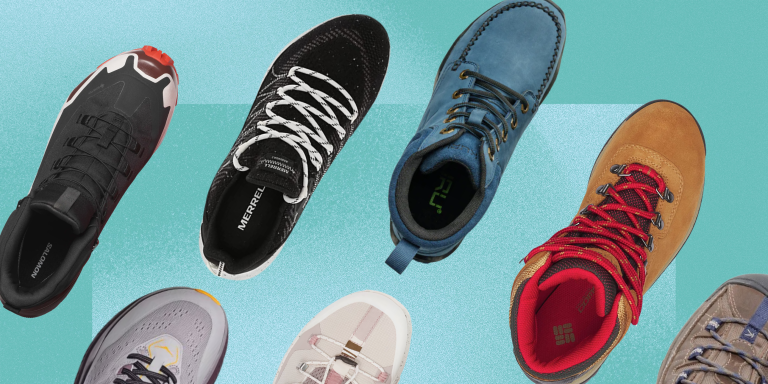
Whether you’re embarking on a multi-mile trek or taking a loop around the park, nothing can put a damper on a hike like foot pain, including the kind that comes with plantar fasciitis. You don’t have to hang up your hiking poles if you’re prone to the condition, though. In the same way that there’s a slew of walking shoes, sneakers, sandals, and clogs that can help mitigate that stabbing heel pain, there are plenty of supportive hiking boots that’ll keep your feet comfortable on the trails.
First, let’s dig into the basics of plantar fasciitis.
Your plantar fascia is a thick band of tissue that stretches from the bottom of your heel bone up to the bottom of your toes, Paulina Piekarska, DPM, a foot and ankle specialist and surgeon at Hartford HealthCare Connecticut Orthopaedic Institute at St. Vincent’s Medical Center, tells SELF. She explains that your plantar fascia is critical for proper arch support, and plays an important role in your overall gait (which is essentially the way you walk). Plantar fasciitis occurs when that tissue, specifically where it attaches at your heel, becomes inflamed, which is most commonly due to overuse or excessive force, Dr. Piekarska says. When that happens, you may feel a sharp, stabbing, or even burning pain in your heel area, and sometimes other parts of your foot, too. The pain is most likely to flare up in the mornings or after spending a while off your feet, per the Mayo Clinic, but Dr. Piekarska says it can sometimes persist throughout the day.
Any weight-bearing activity, including standing, walking, running, and, yes, hiking, can exacerbate plantar fasciitis, Dr. Piekarska says. If you’re dealing with an acute plantar fasciitis flare-up—or don’t want to risk dealing with a lot of pain and soreness after your outing—consider resting and rescheduling your outdoor adventure for another day, Arthur Belanger, DPM, a podiatrist at Holston Medical Group in Johnson City, Tennessee, tells SELF.
How to choose the best hiking boots for plantar fasciitis
First, your boots need to fit comfortably, in both length and width. The toe box should offer enough space for you to wiggle your toes and the heel shouldn’t feel restrictive, tight, or likely to chafe, Dr. Belanger says. You may need to try on a few pairs in order to find the right fit, but a little trial and error is worth avoiding chafing, irritation, and blisters in the long run. That’s a good rule of thumb for anyone shopping for a new pair of hiking shoes, but people with plantar fasciitis should keep a few other key features in mind, too.
Boots with good arch support, a slight heel drop (meaning the difference in height between the forefoot and heel is around 10 mm), and extra cushioning should help prevent pain related to plantar fasciitis, Dr. Belanger says. He adds that if cushioning is your top priority, and you don’t need the ankle support that comes with a boot, you can try lower-cut hiking shoes or trail shoes (just bear in mind that these shoes may have shorter heel drops than boots, he notes).
Dr. Piekarska adds that you should look for a fairly rigid hiking boot, as well. “The more flexible the shoe, the less support the joints in your foot have,” she explains. “[A flexible shoe] requires the plantar fascia, as well as your joints and ligaments, to accommodate your body weight with each step since the shoe is doing little to no work.” Again, don’t hesitate to try on a few different pairs if you can—doing so will help ensure you’ll spend your next hike taking in the scenery, and not worrying about your feet.
Here, we’ve selected some of the best hiking boots for plantar fasciitis, according to our experts’ criteria, with top-rated options from brands like Hoka, Merrell, Salomon, and more.